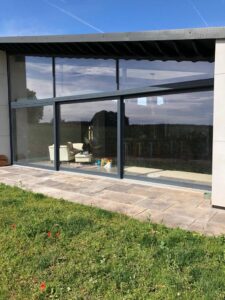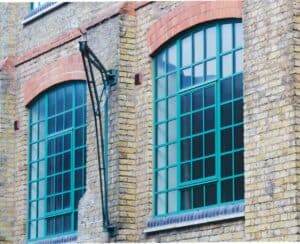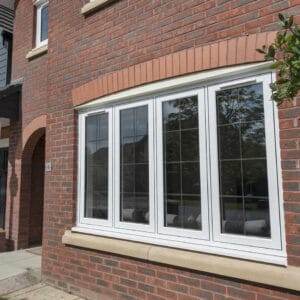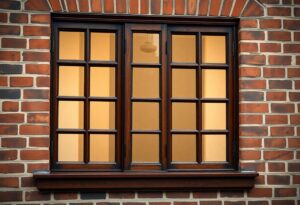Commercial buildings often face challenges related to noise pollution, affecting both productivity and employee well-being. By implementing acoustic windows, you can significantly reduce external noise levels, creating a more comfortable working environment. These specialised windows not only enhance sound insulation but also improve energy efficiency by reducing the need for heating and cooling. Explore how you can Boost Energy Efficiency Through Acoustics in Commercial … to maximise the benefits for your establishment.
Understanding Acoustic Windows
Your understanding of acoustic windows is vital for enhancing sound insulation in commercial buildings. These specially designed windows minimise noise pollution while providing clarity and comfort indoors. The combination of laminated glass with sound-dampening materials and innovative framing techniques sets them apart from standard windows. Acoustic windows are crafted to disrupt sound waves effectively, making them ideal for urban environments.
Definition and Types
About acoustic windows, these architectural features are specifically engineered for sound insulation. The construction typically consists of multiple layers of glass including laminated glass designed to absorb and block sound waves, coupled with specialised framing techniques that prevent sound from entering through gaps. The key differences between standard and acoustic windows lie in their soundproofing capabilities, measured by their Sound Transmission Class (STC) ratings. Here’s a summary:
| Standard Windows | Acoustic Windows |
|---|---|
| Generally single or double-glazed | Made with laminated glass layers |
| Limited sound insulation | High sound insulation capabilities |
| Typical framing techniques | Advanced framing to minimise gaps |
| Lower STC ratings | Higher STC ratings (by design) |
Perceiving the benefits of acoustic windows can significantly enhance your building’s comfort and tranquillity.
How Acoustic Windows Work
Across various settings, acoustic windows operate on the principle of sound insulation, which utilises materials with high sound transmission class (STC) ratings to effectively attenuate noise. This is achieved through the layered structure of laminated glass, which absorbs sound waves and disrupts their pathways. Important to note, the design and material choice play a vital role in performance, ensuring occupants experience a more peaceful environment (choosing the right acoustic window requires consideration of your specific acoustic needs).
For instance, the laminated glass used in acoustic windows features layers of polyvinyl butyral (PVB) inserted between glass layers, which enhances sound dampening properties. The combination of multiple layers and precise framing techniques optimises noise reduction, allowing for a significant decrease in exterior noise levels. This makes acoustic windows a positive investment for many commercial properties (a detailed analysis of noise levels in your area will inform your choice of windows).
Benefits of Acoustic Windows
Some of the most significant benefits of acoustic windows include significantly reduced noise pollution in commercial buildings, leading to improved productivity and overall comfort for occupants. By minimising disruptive sounds, these windows create more hospitable spaces for both employees and clients, allowing for better focus and engagement. (Investing in acoustic windows could transform your work environment immensely.)
Enhanced Acoustic Comfort
The enhanced acoustic comfort provided by these windows is invaluable, as they can drastically lower the decibel levels inside your building. This not only contributes to a more serene atmosphere but also directly impacts your team’s efficiency and collaboration. Furthermore, clients visiting your premises are likely to feel more at ease, positively influencing their overall experience. (Selecting high-quality acoustic windows is an necessary step for your commercial space.)
Increased Energy Efficiency
An additional benefit of acoustic windows is their capacity to improve thermal insulation, which can significantly reduce HVAC costs. The dual advantages of noise reduction and energy savings make acoustic windows a wise investment for your commercial property. By maintaining a stable indoor climate, you create a comfortable environment that encourages productivity and satisfaction. (Prioritising energy-efficient solutions is a smart move for your long-term operational costs.)
Even while enhancing your building’s acoustic performance, you can enjoy substantial reductions in your energy bills. Acoustic windows offer superior insulation, which keeps the warm air in during winter and the cool air in during summer. Implementing these solutions not only helps to protect the environment by lowering your energy consumption but also enhances the aesthetic appeal of your premises. (Choosing the right acoustic solutions is pivotal for your business sustainability.)

Applications in Commercial Buildings
Clearly, acoustic windows play a vital role in various commercial environments, enhancing comfort and productivity. By minimising external noise, these windows create a serene atmosphere, important for businesses that thrive on collaboration and client interaction. Across sectors, their applications range from bustling retail spaces to hospitality venues, ensuring a quieter yet vibrant atmosphere that promotes positive experiences for both employees and customers.
Offices and Workspaces
Any modern office design, especially those featuring open-plan layouts, relies heavily on acoustic windows to reduce distractions and bolster concentration. In environments like tech start-ups and creative agencies, for instance, the installation of these windows has led to noticeable improvements in employee focus and morale. Successful implementations can be observed in numerous firms, where teams benefit from a harmonious blend of natural light and sound insulation, thus enhancing overall productivity.
Educational and Healthcare Facilities
Against the backdrop of busy schools and bustling hospitals, acoustic windows serve an important function in creating quieter spaces that facilitate learning and healing. These installations are particularly significant in areas prone to external noise, where they actively reduce sound pollution. Notable initiatives, such as the refurbishment of a prominent urban school, demonstrate how investing in acoustic technology can lead to improved educational outcomes and a supportive atmosphere for patients (such advancements should be prioritised.)
At the core of educational and healthcare facilities, acoustic windows can significantly improve student performance and patient recovery. By providing a quieter environment, they reduce stress and enhance focus, ultimately paving the way for better learning experiences and faster healing processes. Failure to consider noise control can lead to detrimental effects on both academic success and health outcomes. (It is important to address these considerations in building designs.)
Installation Considerations
After assessing the need for acoustic windows, it’s vital to consider installation aspects. Proper placement and integration with existing structures are vital to achieving optimal sound insulation. You can explore insights on Acoustic Window Design to inform your decision-making process for a more effective installation.
Professional Installation Recommendations
Against the backdrop of achieving the desired acoustic performance, professional installation plays an important role. Key factors include determining the optimal window placement and ensuring seamless integration with your existing structures. To maximise effectiveness, you should consult with experts who can provide tailored advice based on your specific environment (selecting a reputable installer can lead to significant performance benefits).
Maintenance and Upkeep
Below are some vital guidelines for maintaining acoustic windows to ensure their long-lasting performance. Regularly check for signs of wear, such as sealing deterioration or condensation between panes, which can affect soundproofing. If issues arise, addressing them promptly using troubleshooting steps can optimise their efficacy over time.
Understanding the importance of maintenance is key to enjoying the full benefits of your acoustic windows. Regular inspections can help you identify potential problems before they escalate, ensuring that your windows remain effective against noise pollution. Simple tasks like cleaning the frames and checking seals will contribute positively to your windows’ longevity, while neglecting these aspects could lead to significant performance drops.
Future Trends in Acoustic Windows
Many emerging trends in materials and technology are set to revolutionise the way you think about acoustic windows. Advancements in smart glass allow for dynamic control of sound transmission, enabling you to create adaptable environments in your commercial buildings. Additionally, innovative noise-reducing coatings enhance the soundproofing capabilities of windows, contributing to a more pleasant atmosphere for occupants. These innovations not only improve acoustic performance but also influence the overall design and building standards significantly, ensuring that your projects remain competitive and compliant in an evolving market.
Summing up
Presently, incorporating acoustic windows in your commercial building can significantly enhance the overall environment, offering you a quieter, more productive space. Their ability to reduce external noise pollution not only protects the comfort of occupants but also contributes to improved focus and well-being. By investing in these windows, you can enhance your property’s value while fostering a more pleasant atmosphere for both employees and clients, making them a strategic choice for forward-thinking businesses.
FAQ
Q: What are acoustic windows and how do they work?
A: Acoustic windows are specially designed windows that incorporate soundproofing features to reduce the transmission of noise from the outside environment into a building. They typically consist of multiple layers of glass, often with different thicknesses, and may include an air gap or acoustic membranes to enhance their sound insulation properties. These elements work together to absorb and reflect sound waves, ultimately minimising unwanted noise entering the premises.
Q: What are the main benefits of installing acoustic windows in commercial buildings?
A: The installation of acoustic windows in commercial buildings offers several benefits, including significant noise reduction, which can enhance employee productivity and comfort. They can also improve privacy for offices and meeting rooms, create a more pleasant environment for customers, and potentially increase property value. Furthermore, acoustic windows often come with energy-efficient properties, helping to lower heating and cooling costs.
Q: In what types of commercial buildings are acoustic windows most beneficial?
A: Acoustic windows are particularly beneficial in urban areas or locations near busy roads, railways, or airports, where noise pollution is a concern. They are commonly used in offices, hotels, hospitals, educational institutions, and residential buildings near commercial areas. Essentially, any establishment that requires a quiet environment for work or rest can benefit from the installation of acoustic windows.
Q: Can acoustic windows be customised to fit existing windows in a commercial building?
A: Yes, acoustic windows can be customised to fit various existing window frames and styles in commercial buildings. Many manufacturers offer tailored solutions that ensure seamless integration with the current architecture while adhering to soundproofing requirements. It is advisable to consult with a professional to determine the best fit and acoustic specifications for the building in question.
Q: How do acoustic windows contribute to energy efficiency in commercial spaces?
A: Acoustic windows often feature multiple layers of glass and insulating materials that help reduce heat transfer, making them highly energy-efficient. By minimising sound transmission, they also limit the need for additional climate control measures to maintain comfort in noisy environments. This improved thermal performance can lead to lower energy bills and a reduced carbon footprint, making them an environmentally friendly choice for many businesses.
Q: What is the installation process for acoustic windows, and how long does it take?
A: The installation process for acoustic windows typically involves the removal of the existing windows and replacement with the new acoustic models. The time required for installation can vary depending on the size and complexity of the project, but it generally takes a few hours to a couple of days. Professional installers will assess the site beforehand, ensuring an efficient and secure fitting that meets all safety standards.
Q: Are there any maintenance requirements for acoustic windows once installed?
A: Acoustic windows require minimal maintenance compared to traditional windows, but regular inspections and cleaning are recommended to ensure optimal performance. This includes checking seals, frames, and sills for any signs of wear or damage, as well as cleaning the glass to maintain clarity and aesthetics. Consulting the manufacturer’s guidelines will provide specific maintenance requirements for the acoustic windows installed in a particular commercial space.













